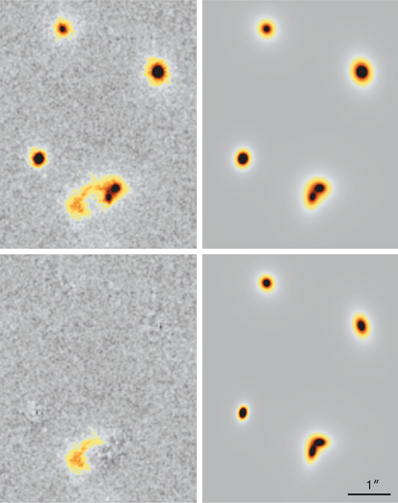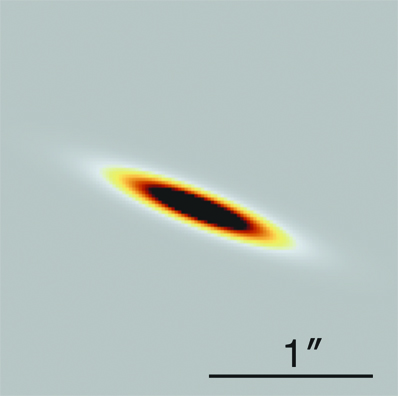|

Top Stories

|

|
 |
 |



Stars born in
galactic centre
...Stars have been seen being born in the inner sanctum of our Milky Way Galaxy, answering the question of whether stars can form there or instead have to migrate there...
read more

The black cloud set to blossom into a giant star
...A freezing cold, dark cloud of molecular hydrogen is beginning to stir up the materials for building a giant star, or even several massive stars, in a forbidding region of the Milky Way known as the Aquila Rift...
read more

Planet-forming disc found orbiting twin suns
...Images collected with the Smithsonian's Submillimeter Array (SMA) radio telescope system reveal the presence of a molecular disc orbiting a young binary star system...
read more |
 |
 |

|
Spaceflight Now +

|

|
 |
 |

Subscribe to Spaceflight Now Plus for access to our extensive video collections!
 How do I sign up? How do I sign up?
 Video archive Video archive

STS-120 day 2 highlights

Flight Day 2 of Discovery's mission focused on heat shield inspections. This movie shows the day's highlights.

 Play Play

STS-120 day 1 highlights

The highlights from shuttle Discovery's launch day are packaged into this movie.

 Play Play

STS-118: Highlights

The STS-118 crew, including Barbara Morgan, narrates its mission highlights film and answers questions in this post-flight presentation.

 Full presentation Full presentation
 Mission film Mission film

STS-120: Rollout to pad

Space shuttle Discovery rolls out of the Vehicle Assembly Building and travels to launch pad 39A for its STS-120 mission.

 Play Play

Dawn leaves Earth

NASA's Dawn space probe launches aboard a Delta 2-Heavy rocket from Cape Canaveral to explore two worlds in the asteroid belt.

 Full coverage Full coverage

Dawn: Launch preview

These briefings preview the launch and science objectives of NASA's Dawn asteroid orbiter.

 Launch | Science Launch | Science

 Become a subscriber Become a subscriber
 More video More video

|
 |
 |

|
|
 |

Lasers help astronomers probe distant galaxies
BY KEITH COOPER
ASTRONOMY NOW
Posted: 11 June, 2009
A discrepancy between the types of galaxies in today’s Universe and those that existed shortly after the big bang is becoming clearer following new observations of galaxies that existed 2.7 billion years after the big bang.
The observations took advantage of the laser guide-star adaptive optics system on one of the ten-metre Keck Telescopes in Mauna Kea in Hawaii. By creating an artificial star in the sky with the laser, astronomers can monitor turbulence in the atmosphere that typically distorts images, and compensate for it to get distortion-free images.

A group of distant and luminous galaxies including the radio galaxy TXS 2332+154, which has been measured to have a redshift of 2.48. All of the galaxies except for the radio galaxy have old stellar population. The galaxy on the lower left is more massive than our Milky Way, yet it is only 3,000 light years across. Image: Alan Stockton et al.
Training the Keck on several distant galaxies that existed in the young Universe, Dr Alan Stockton of the University of Hawaii, and Drs Gabriela Canalizo and Elizabeth McGrath from the University of California, found that despite their young age, these galaxies had all but ceased their star-forming activities a billion years earlier. The galaxies can be divided into two types: very small disc galaxies and even smaller, compact agglomerations of stars with high surface brightness, meaning we can see them despite their distance.
“In the most extreme cases… some of these galaxies pack all of the stars of a fairly massive present-day galaxy into a volume about a thousand times smaller,” says Stockton. Indeed, assuming that their masses have not been overestimated (a possible outcome were these galaxies to contain more massive, luminous stars than smaller stars like the Sun, which in itself would be interesting), then the most compact galaxies have a diameter of just over 3,000 light years across – about the same as a typical dwarf galaxy – but with the mass of the Milky Way, which is 100,000 light years across. It’s not the first time that such compact massive galaxies have been seen in the distant Universe either, and traditional models of galaxy formation, whereby smaller galaxies merge to form larger galaxies (called hierarchical formation), cannot explain their existence. Instead, these massive galaxies must have formed all in one go.

A distant edge-on disc galaxy imaged by the Keck Telescope, dominated by stars that are two billion years old. Image: Alan Stockton et al.
The discrepancy between these distant galaxies (which are at a redshift of 2.5, meaning their light has taken 11 billion years to reach us) and galaxies in the modern Universe is that these compact galaxies are nowhere to be found today. What happened to them? One idea is that they may have merged with other galaxies, acquiring a diffuse envelope of stars in their halo as they do. Alternatively, dynamical collapse may have seen the stars in the cores of these galaxies fall onto one another to create the supermassive black holes seen in the centres of galaxies today, whilst stars in their outer regions would have seen their orbits widen, causing the galaxy to puff up into a more diffuse and less dense galaxy. |
 |
 |
 |
|
|



